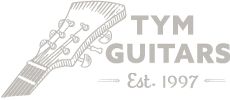Guyatone LG-50T and EB-1
Share
The two things that influenced the Japanese guitar scene in the sixties more than anything else was the Beatles and the Ventures. The influence the Beatles had on guitar manufacturing and sales worldwide can't be overstated. The Ventures however have influenced millions while still being considered a "novelty surf group" by many. While they were massive in other markets, they really hit a nerve in Japan, where they were treated like, the Beatles.

The Ventures first toured Japan in 1962 and had a huge impact on a still very "acoustic" guitar population. When they returned in '64 Japan had been completely hit by the electric guitar boom. They were greeted at the airport by thousands of fans and the tour could be described as "Venturesmania" as Ventures cover and soundalike bands sprung up everywhere.

The Ventures were playing a beautiful guitar by a small guitar manufacturer working out of Bakersfield, Ca called Mosrite and they all played Mosrite Ventures models which were emblazoned all over their record covers. The Japanese couldn't get enough of them, and they became one of the most copied (and influential) designs by Japanese manufacturers throughout the sixties.


Mosrites were expensive, even by US guitar standards and the cost of buying them and importing them into Japan was prohibitive so local manufacturers jumped on the opportunity to make cheaper guitars influenced by the Ventures model. While good quality copies were a few years away by the mid sixties Guyatone jumped on the wagon early in 1965 and started making the entry level LG-50T and the matching EB-1 bass, both heavily influenced by the Mosrite Ventures.


While these are nothing like a Mosrite in quality, they would have been many Japanese teenagers first "Mosrite" as they were cheap at 9,000 yen for the guitar and 12,000 yen for the bass compared to the LG-150T at 17,000. The LG-127 would come along soon to fill the gap at 12,700.


These are typical of entry level mid sixties Guyatones with thin laminated bodies although with a rudimentary German carve, which was of course a feature on Mosrites. The bodies are light and comfortable but do feel a little .... thin.


The necks are bolt on Asian mahogany with rosewood fretboards and are not as thick as earlier necks from Guyatone. They are actually very comfortable and play really well. They would have been ... adequate for a beginner trying to learn Walk, Don't Run.


The pickups are typical mid sixties "gold foil" units used by Guyatone around this time that had been used as far back as '62 in a similar form. They are clear and nice and have good output. They sound great through a small valve amp.

The hardware is all typical Guyatone for the period with a fully adjustable bridge on the guitar and a non intonatable "bar" on the bass. The vibrato on the guitar works well and is based on an offset unit but is not as smooth. The electrics are all fine and the tuners are of a decent quality.
The bass is exactly the same body and neck as the guitar as was done by both Guyatone and Teisco at the time making this a 24.5" scale bass. These were popular in mid sixties Japan for beginners and it wasn't until the later mid sixties that basses started getting a "longer" 30" (short scale) neck and eventually the standard 34". These basses are actually pretty cool and easy to play, once you get used to them. They don't thump like a P bass but then, you wouldn't expect them to.

These two Guyatones were an introduction to guitar and Mosrites for many Japanese kids and as demand (and the guitar boom) grew, Japanese manufacturers would make better and better Mosrite copies culminating in First Man making the Avenger and turning into Mosrite Japan in '69. The Avenger was the first copy to come close to a "real" Mosrite in Japan and they sold really well. By the early seventies the Mosrite Japan guitars were getting better and closer still and would go on to make some of my favourite "Mosrites", but that's a WHOLE other story.

